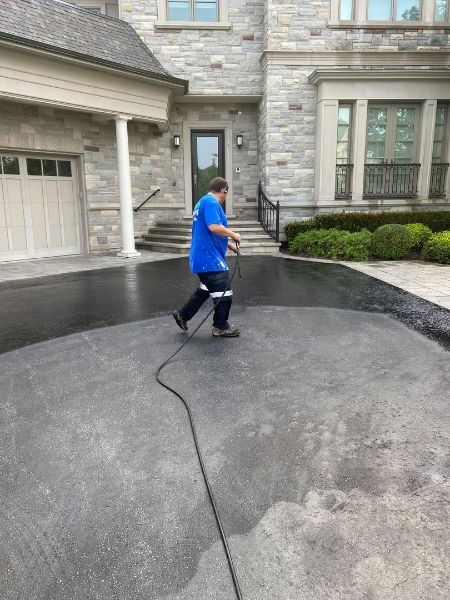Discover the Power of Commercial Parking Area Paving and Asphalt Sealing
Wiki Article
Warm Mix Asphalt: A Lasting Remedy for Sidewalk
Hot Mix Asphalt (HMA) has actually arised as a leading sustainable option for pavement services, providing a myriad of ecological benefits and cutting-edge technologies. As the demand for eco-friendly construction practices expands, discovering the nuances of HMA's sustainability can provide useful insights into the future of sidewalk services.Ecological Benefits of Warm Mix Asphalt
.png)
Additionally, Warm Mix Asphalt helps to minimize urban warmth island impacts. Its dark shade takes in sunshine, decreasing the quantity of heat showed back right into the environment contrasted to lighter-colored pavements. This can reduce ambient temperature levels in urban locations, decreasing the demand for cooling and ultimately minimizing power consumption.
On top of that, Warm Mix Asphalt contributes to improved stormwater administration. Its permeable nature permits water to penetrate the pavement and recharge groundwater materials, minimizing drainage and the threat of flooding. These ecological advantages make Warm Mix Asphalt a sustainable choice for paving roads and highways.
Energy Efficiency in HMA Production
Is power performance an important aspect in the production of Warm Mix Asphalt (HMA)? Power plays a considerable role in the manufacturing of HMA, affecting both cost and ecological sustainability. One essential aspect of power efficiency in HMA manufacturing is the usage of warm mix asphalt (WMA) modern technologies.Moreover, improvements in plant technologies have actually led to even more energy-efficient HMA production processes. By maximizing energy use in HMA manufacturing, the market can minimize its carbon impact while preserving premium pavement products.
Recyclability of Warm Mix Asphalt
The recyclability of Warm Mix Asphalt (HMA) is a pivotal element of its sustainability and long-term environmental impact. HMA is among the most recycled materials in the United States, with over 100 million lots of reclaimed asphalt sidewalk (RAP) being reused every year in brand-new pavement building and construction. Reusing HMA supplies several ecological advantages, such as decreasing the need for virgin materials, lowering energy consumption during production, and reducing the amount of waste sent to landfills.The procedure of recycling HMA involves grating the existing pavement, crushing it right into smaller sized pieces, and mixing it with new aggregate and asphalt binder to develop a recycled mix. This recycled mix can often execute as well as or also better than standard HMA, while calling for less basic materials and generating reduced greenhouse gas emissions. By including RAP into new pavement projects, roadway agencies can save natural resources, minimize prices, and lessen the environmental impact of road building and construction and upkeep tasks. In general, the recyclability of HMA plays a substantial function in promoting sustainable techniques within the pavement sector.

Long-Term Efficiency of HMA
Asphalt sidewalks show longevity and resilience over an extended duration, showing the long-lasting efficiency of Hot Mix Asphalt (HMA) The durability of HMA can be associated to its capacity to hold up against rush hour tons, extreme weather, and the results of aging. Researches have shown that well-designed and appropriately created HMA sidewalks can last for two decades or more with routine upkeep. The secret to taking full advantage of the long-term efficiency of HMA depends on utilizing high-grade materials, following ideal practices in construction, and applying effective maintenance approaches. Proper drainage, regular assessments, and prompt repair services are vital for preserving the structural stability of HMA pavements Homepage gradually. Additionally, developments in HMA innovation, such as the use of polymer-modified binders and cozy mix asphalt, have even more improved the sturdiness and long life of HMA pavements. By focusing on top quality building and construction and maintenance practices, HMA continues to confirm itself as a cost-effective and sustainable remedy for durable pavement facilities.
HMA: Resilience and Sustainability
Showing both toughness and sustainability, Hot Mix Asphalt (HMA) has come to be a cornerstone in the construction of durable pavement frameworks - commercial parking lot paving. HMA's sturdiness originates from its capability to hold up against heavy loads, severe climate condition, and high website traffic volumes, making it a trusted choice for roads, highways, and flight terminal runways. The composition of HMA, which usually includes accumulations, binder, and filler, plays a crucial function in anchor boosting its long life and resistance to tear and use
In addition, HMA's sustainability exists in its recyclability and energy-efficient manufacturing procedure. The capability to reuse reclaimed asphalt pavement (RAP) in brand-new HMA mixtures decreases the demand for virgin materials and reduces the environmental effect of pavement building and construction and upkeep. Additionally, the energy performance of generating HMA hinges on its lower blending temperatures compared to other pavement materials, leading to reduced power usage and greenhouse gas emissions.
Conclusion
In verdict, warm mix asphalt (HMA) supplies a sustainable remedy for sidewalk with its eco-friendly attributes. HMA's recyclability, energy effectiveness in manufacturing, and lasting toughness make it an environment-friendly choice for roadway building. By conserving natural sources, reducing waste, and reducing greenhouse gas emissions, HMA plays an essential role in promoting sustainability in facilities growth. Its capability to alleviate metropolitan warmth island results even more highlights its relevance in read this producing ecologically aware and resilient sidewalk systems.
HMA is one of the most recycled materials in the United States, with over 100 million bunches of recovered asphalt pavement (RAP) being reused yearly in brand-new sidewalk building.The procedure of recycling HMA includes grating the existing pavement, crushing it into smaller pieces, and blending it with brand-new accumulation and asphalt binder to create a recycled mix.Asphalt sidewalks demonstrate toughness and strength over a prolonged duration, mirroring the lasting performance of Warm Mix Asphalt (HMA) Furthermore, improvements in HMA modern technology, such as the use of polymer-modified binders and warm mix asphalt, have even more improved the toughness and long life of HMA sidewalks. The capacity to reuse reclaimed asphalt pavement (RAP) in new HMA blends lowers the need for virgin products and decreases the ecological influence of sidewalk building and construction and maintenance.
Report this wiki page